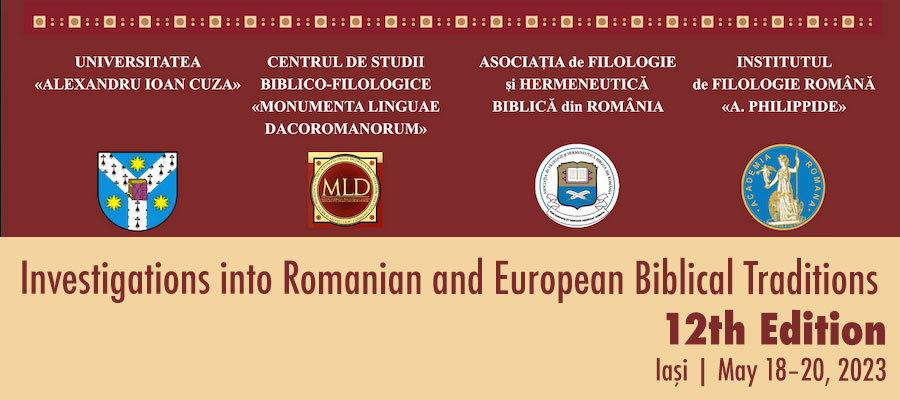Investigations into Romanian and European Biblical Traditions, 12th Edition, Iaşi, May 18–20, 2023
The Symposium aims to encourage multi- and interdisciplinary debates on the issues raised by the publication, translation, interpretation, dissemination and reception of sacred texts into Romanian and other modern languages.
Sections
Philological Challenges
- Publication of the biblical texts. Textual criticism and palaeography. Sacred texts computerization and digitization.
- The biblical text as a reference point in the diachronic study of language. Lexicology and biblical semantics. Biblical phraseology. Biblical onomastics.
- Lesser known, partial translations of the Bible: books and book fragments kept in old manuscripts from the 16th and 17th centuries, and their textual relationship with popular Romanian versions.
- Stylistic interference and demarcation: biblical, liturgical and theological-sapiential varieties of clerical styles. The role of the Bucharest Bible (1688) in the creation of the Romanian clerical style in the 18th and 19th centuries.
Translation Challenges
- Typology of biblical translations. Literal and free translation. Translation theory and sacred texts.
- Unique source vs. multiple source. The “original texts” of the Bible – different textual traditions reflected in the Romanian translations.
- Relationships among successive biblical versions: the Sibiu Gospels (1551-1553) and the Coresi Gospels; the Coresi Gospels and Epistles and the Bălgrad New Testament (1648); the Bucharest Bible (1688) and the Blaj Bible (1795); the Blaj Bible and the Şaguna, Filotei editions and the 1914 Bible, the Cornilescu versions etc.
- Reference works for all time Bible translations: lexicons, dictionaries, concordances, critical editions, auxiliary versions, etc.
Biblical Hermeneutics
- Confessional and theological choices and conditioning (dogmatic, canonical, clerical, worship-related etc.). Theological censorship, political censorship.
- Patristic tradition — reference points and criteria for sacred texts’ interpretation.
- The Bible and the literary clerical system: relationships and determinations between the sacred text and clerical hymnography, worship-related literature, iconography, exegetic and homiletic literature.
Sacred Texts’ Historical Reception
- Integration, dynamics and stylization of biblical quotations in Romanian and other literatures.
- Dissemination of Romanian Bible versions. Historical references and main Romanian biblical versions criticism (the Bucharest Bible, the Blaj Bible etc.). Textual relationships (borrowing, “corrections”, adaptations etc.) between different biblical versions.
- Romanian culture and the Bible. Biblical motifs, symbols, structures and characters.
- Cultural interferences and mentalities impacting the reception of sacred texts: anthropological, sociological, political or philosophical aspects.
In addition to the traditional sections, for this edition the organizers propose two thematic sections:
Saint Nicodemus of Tismana – 700 years. Production and transmission of the biblical manuscript in the Byzantine Commonwealth
These years mark seven centuries since the Saint Nicodemus of Tismana’s birth, the author of the oldest dated manuscript from Wallachia and the founder of the first Romanian monasteries. These were the first major cultural centers in the Romanian countries, incorporated into the network of cultural centers already existing in the Byzantine Commonwealth of Greek and Slavonic languages, which produced biblical manuscripts of great value, with circulation throughout this cultural area, on which the oldest biblical Romanian texts are based. We propose the following thematic directions, any other approaches are welcome:
- Nicodemus’ Tetraevangelion – the oldest dated manuscript from Wallachia
- Byzantine biblical lectionaries: production, typikon, circulation, textual tradition
- Biblical manuscripts in the monastic scriptoria and libraries of the Byzantine Commonwealth
- Biblical manuscript copying and diffusion centers in the Byzantine Commonwealth
- Patrons, scribes, calligraphers, illuminators and possessors of biblical manuscripts
- Illumination of biblical manuscrips in the Byzantine Commonwealth
- From the Old Church Slavonic to the oldest Romanian lectionaries: Tetraevangelion, Apostle, Psalter and Prophetologion
350 years since the publication of the Dosoftei’s Rhymed Psalter. The versification of the Psalms in the Romanian and European culture
- Dosoftei’s Rhymed Psalter: sources, genesis, reception
- Dosoftei’s Rhymed Psalter as a monument of the Romanian language
- The place of Dosoftei’s Rhymed Psalter in the history of Romanian literature
- Rhymed / Metrical Psalters in the European culture
- Versification as interpretation
- Rhymed Psalters in Romanian literature: Teodor Corbea (ca 1705), Ioan Prale (1827), Nicolae Liciu (1846), Vasile Militaru (1933), Eugenia Adams Mureşanu (1985), etc.
We also welcome other interpretations of the Conference theme.
The official languages of the Symposium will be Romanian, English and French.
The conference fee is 180 lei (40 Euro).
